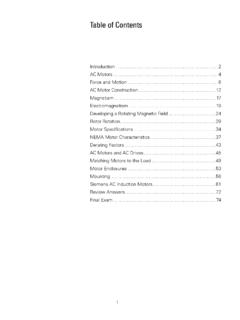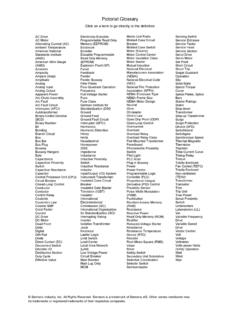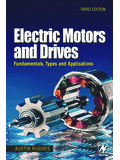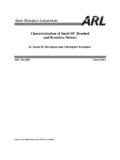Transcription of Basics of AC Motors-Chapter 1rev - sitrain.us
1 Basics of AC MotorsA quickSTEP Online Siemens Industry, Inc. Siemens Industry, Inc. 2016 TrademarksSiemens is a trademark of Siemens AG. Product names mentioned may be trademarks or registered trademarks of their respective Electrical Code and NEC are registered trademarks of the National Fire Protection Association, Quincy, MA is a registered trademark and service mark of the National Electrical Manufacturer s Association, Rosslyn, VA Laboratories Inc. and UL are registered trademarks of Underwriters Laboratories, Inc.,Northbrook, IL trademarks are the property of their respective 1-2 Siemens Industry, Inc.
2 2016 Course TopicsWelcome to Basics of AC Motors. This course covers the following topics: chapter 1 - introduction Basic ConceptsChapter 2 motor Basics Electromagnetism Rotor RotationChapter 3 NEMA Motors motor Designs motor EnclosuresChapter 4 Siemens Motors NEMA Motors IEC Motors Above NEMA MotorsIf you do not have an understanding of basic electrical concepts, you should complete Basics of Electricity before attempting this 1-3 Siemens Industry, Inc. 2016 Course ObjectivesUpon completion of this course you will be able Explain the concepts of force, inertia, speed, and torque Explain the difference between work and power Describe the construction of a squirrel cage AC motor Describe the operation of a rotating magnetic field Calculate synchronous speed, slip, and rotor speed Identify the starting torque, pull-up torque, breakdown torque.
3 And full-load torque on a NEMA B motor speed-torque curve Describe the information displayed on a NEMA motor nameplate Identify important motor derating factors Identify NEMA enclosures and mounting configurations Summarize the types of Siemens SIMOTICS motors availablePage 1-4 Siemens Industry, Inc. 2016 SIMOTICS MotorsThis course primarily focuses on building your basic knowledge of NEMA three-phase induction motors, which are part of Siemens extensive SIMOTICS motor product line. SIMOTICS industrial electric motors provide you with the optimum solution for every application. Backed by 150 years of experience, SIMOTICS motors are unrivaled when it comes to reliability, ruggedness, compactness, efficiency, and performance.
4 SIMOTICS electric motors include: Low voltage AC motors for line and converter operation Precise motion control motors with highly-dynamic performance for positioning and handling, as well as for use in production machines and machine tools DC motors and powerful high-voltage motors for use in ships, rolling mills, ore mills, and large mud pumps and compressors in the oil and gas industryPage 1-5 Siemens Industry, Inc. 2016 SITRAIN Training for IndustryPage 1-6 Online Self-paced Learning Programs with maximum flexibility so students can easily fit courses into their busy schedulesVirtual Instructor-led Learning - Classroom lectures delivered in the convenience of your home or officeClassroom Learning - Expert and professional instructors, proven courseware, and quality workstations combine for the most effective classroom experience possible at your facility or oursHow-to Video Library - Quick, affordable.
5 Task-based learning options for a broad range of automation topics for training or purchaseSimulators - World-class simulation systems available for training or purchaseThis course also describes learning options available from the Siemens SITRAIN USA organization and our global SITRAIN partners. For additional information: Siemens Industry, Inc. 2016 chapter 1 IntroductionThis chapter covers the following topic: Basic Concepts AC motor ConstructionPage 1-7 Siemens Industry, Inc. 2016AC MotorsAC motors are used worldwide in many applications to transform electrical energy into mechanical energy.
6 There are many types of AC motors, but this course focuses on three-phase induction motors, the most common type of motor used in industrial applications. An AC motor of this type may be part of a pump or fan or connected to some other form of mechanical equipment such as a winder, conveyor, or mixer. Siemens manufactures a wide variety of AC addition to providing basic information about AC motors in general, this course also includes an overview of Siemens SIMOTICS NEMA AC motors, which range from general purpose motors in Aluminum frame, to sophisticated three-phase motors that meet or exceed IEEE 841 and NEMA Premium summary information is also included for Siemens IEC and Above NEMA 1-8 Siemens Industry, Inc.
7 2016 Standards OrganizationsThroughout this course, reference is made to the National Electrical Manufacturers Association (NEMA). NEMA develops standards for a wide range of electrical products, including AC motors. For example, NEMA Standard Publication MG 1 covers NEMA frame size AC motors, commonly referred to as NEMA motors. In addition to manufacturing NEMA motors, Siemens also manufactures motors larger than the largest NEMA frame size. These motors are built to meet specific application requirements and are commonly referred to as above NEMA also manufactures motors to International Electrotechnical Commission (IEC) standards.
8 IEC is another organization responsible for electrical standards. IEC standards perform the same function as NEMA standards, but differ in many respects. In many countries, electrical equipment is commonly designed to comply with IEC standards. In the United States, although IEC motors are used, NEMA motors are more common. Keep in mind, however, that many companies build products for export to countries that follow IEC 1-9 Siemens Industry, Inc. 2016 ForceBefore discussing AC motors and drives, it is necessary to discuss some of the basic terminology associated with their simple terms, a force is a push or pull.
9 Force may be caused by electromagnetism, gravity, or a combination of physical force is the vector sum of all forces that act on an object, including friction and gravity. When forces are applied in the same direction, they are example, if two 10 pound forces are applied in the same direction, the net force is 20 pounds. If 10 pounds of force is applied in one direction and 5 pounds of force is applied in the opposite direction, the net force is 5 pounds, and the object moves in the direction of the greater force. If 10 pounds of force is applied equally in both directions, the net force is zero, and the object does not 1-10 Siemens Industry, Inc.
10 2016 TorqueTorque is a twisting or turning force that causes an object to rotate. For example, a force applied to a point on a lever applies a torque at the pivot point. Torque is the product of force and radius (lever distance).Torque = Force x RadiusIn the English system of measurements, torque is measured in pound-feet (lb-ft) or pound-inches (lb-in). For example, if 10 lbs of force is applied to a lever 1 foot long, the resulting torque is 10 increase in force or radius results in a corresponding increase in torque. Increasing the radius to two feet, for example, results in 20 lb-ft of 1-11 Siemens Industry, Inc.








